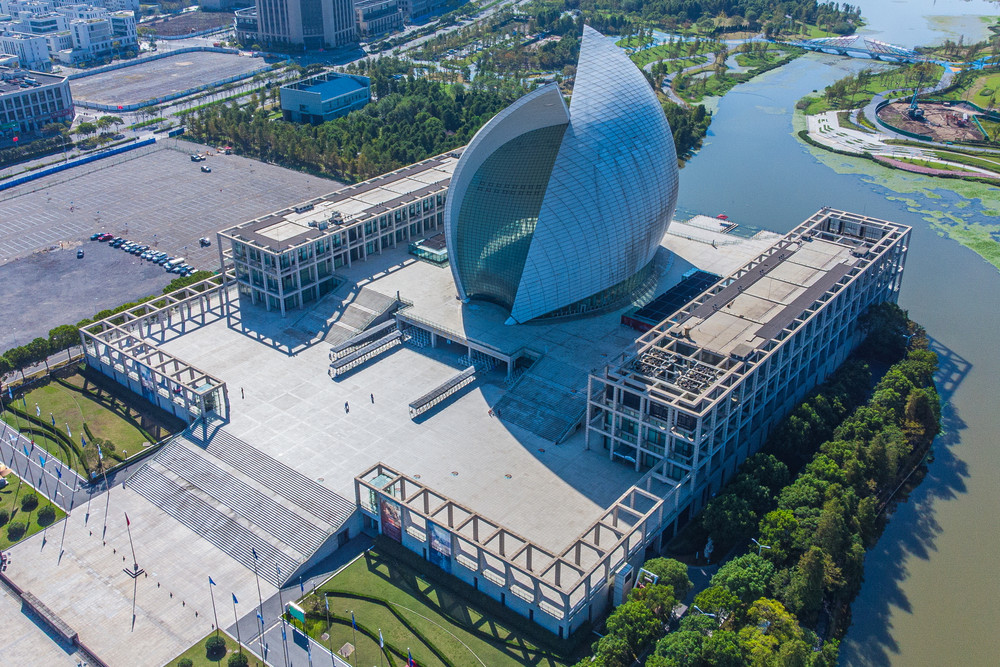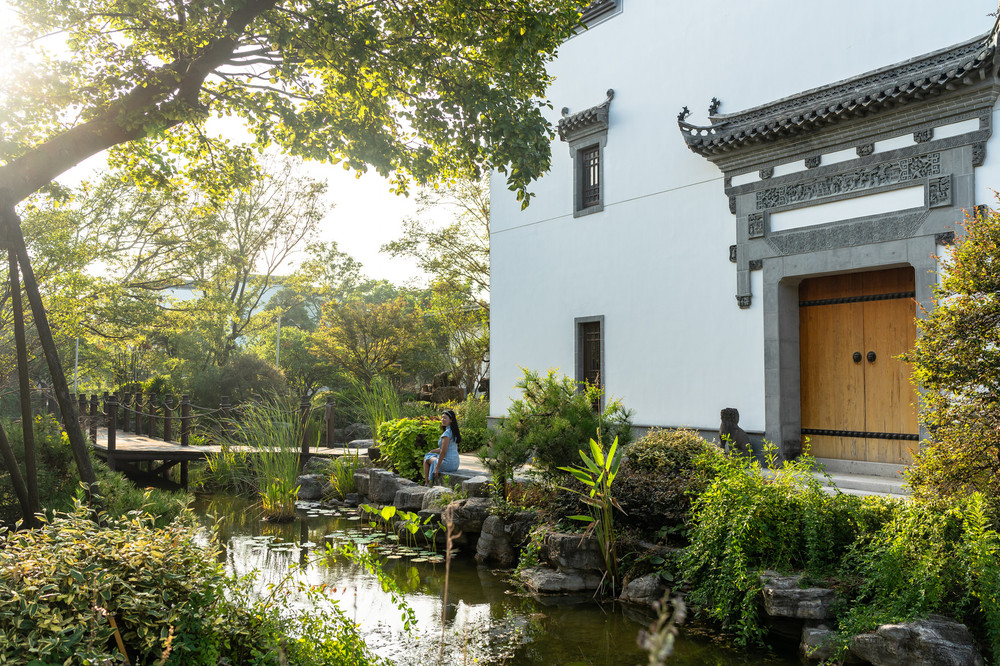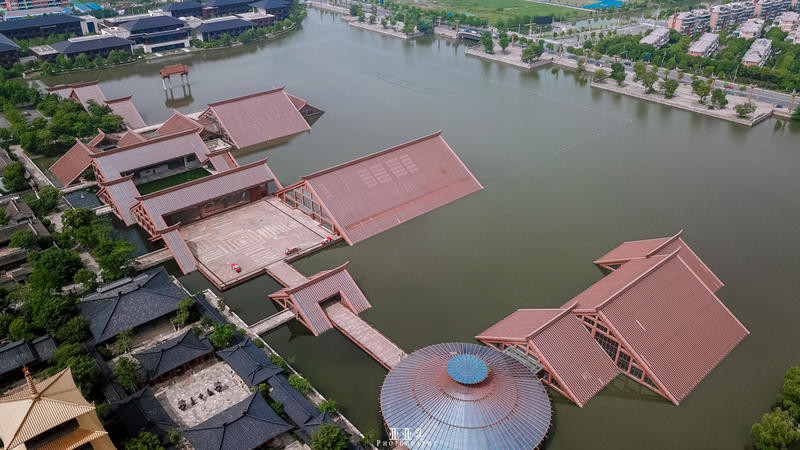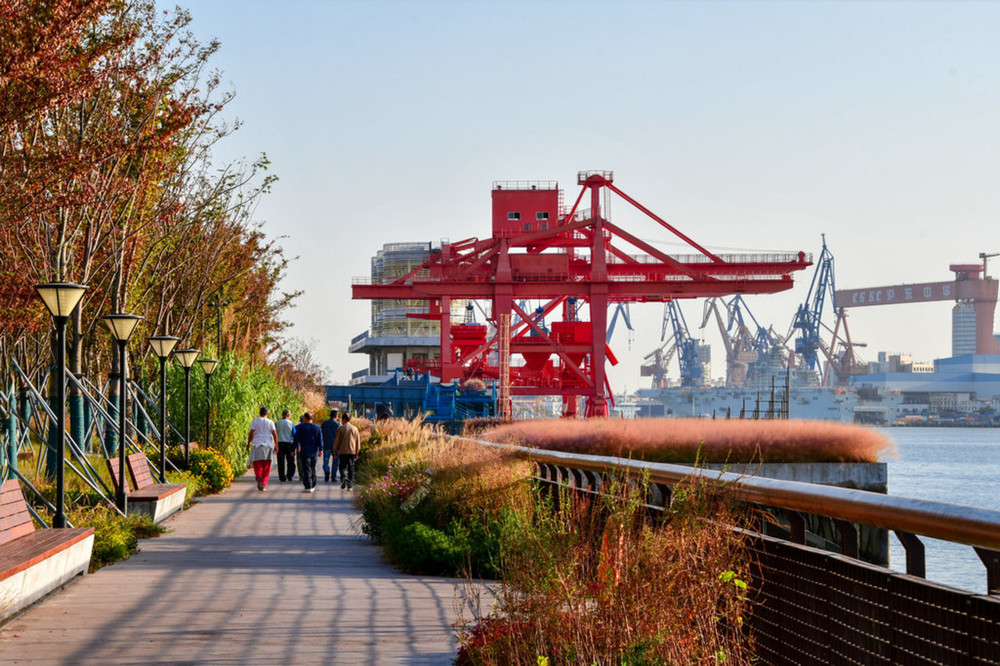**Trip Overview**

**Duration:** 1 day
**Time:** October
**Per capita cost:** 200 yuan
**With whom:** Friends
**Ways to play:** Photography, independent travel, weekend tour
**Visited Places:**
– China Maritime Museum
– Shanghai Dishui Lake
– Donghai Bridge
**Posted on:** October 20, 2021, 11:10
—
**Preface:**
The China Maritime Museum is one of the few museums in Shanghai with the title of ‘China’. It is also currently the only national maritime museum in China. This new museum that was put into operation in 2010 almost covers all the functions of modern museums. Here, there is a 1:1 real ship according to the treasure ship that Zheng He took on his voyages to the Western Seas, as well as modern ship models. Visitors can learn essential knowledge for sailors such as tying sailor’s knots through interactive sessions. Here, visitors seem to shuttle constantly between ancient and modern times and feel different maritime eras. Do you want to come in and take a look?
—
**China Maritime Museum:**
The China Maritime Museum is in the Lingang New City area where there are not many high-rise buildings. From a distance, you can see two white sails. This is the China Maritime Museum that I will share with you today. It is composed of a two-story base building and two wing buildings. The two steel structure central sail bodies about 70 meters high standing on the two-story base building are the highlights of the entire building. Its architectural shape is like two white sails, highlighting the marine theme and being novel and visually impactful.
—
**Tour Guide:**
The exhibition areas in the museum are divided into three floors. The first floor is equipped with the Maritime History Hall, Ship Hall, Sailor Hall, and special exhibition areas for fishing boats and fishing. The second floor is equipped with the Navigation and Port Hall, Maritime Affairs and Maritime Safety Hall, Military Navigation Hall, and special exhibition areas for maritime sports and leisure. The museum also has a planetarium, 4D cinema, and children’s activity center. The recommended tour order is to take the escalator down to the first floor after entering and start visiting. The museum has free guided tour services on weekends and holidays. Usually, there is one in the morning and one in the afternoon for each exhibition hall. It is recommended to follow the guide’s explanations and visit in turn. The quality of the guides here is very high. They can not only easily explain most of the maritime history, but also are familiar with all the exhibits in the museum.
—
**First Impression:**
Stepping into the hall of the museum, the first thing that catches the eye is a Fuchuan ship completely made according to ancient craftsmanship. The construction of this ship is carried out completely in accordance with ancient craftsmanship according to historical literature records. There are two stern towers at the stern of the ship, and there is a raised deck, three masts, and three sails. The main mast is 26.6 meters high. The structure adopts traditional Chinese shipbuilding technologies such as mortise and tenon connection and watertight compartments. The Fuchuan ship is one of the four major ship types in ancient China and also the most famous sea ship type. According to expert research, the treasure ship that Zheng He took on his voyages to the Western Seas is of Fuchuan ship type. This ship is not only for tourists to look at the excitement. The most important thing is that it can also be boarded for a tour and participate in various interactive activities. In the area in front of the Fuchuan ship, there are specially displayed the main warships such as aircraft carriers and destroyers independently designed and completed by our country, which is very exciting.
—
**Exhibition Details:**
The Maritime History Hall is divided into three exhibition areas: ancient, modern, and contemporary, taking time as the main line; taking technology as the hidden line, through the introduction of shipbuilding and navigation technologies such as buoyancy crossing water, dugout canoe, wooden ship, sail, oar, scull, rudder, and compass, it shows the invention and evolution process of Chinese navigation technology.
Not only can children greatly expand their knowledge here, but adults can also learn a lot about the history and facts of navigation. A pure gold-made Spring and Autumn Dynasty warship is exquisitely crafted! Upon close inspection, even the movements of the soldiers on the deck and in the cabin are vividly depicted! Not far away is the ‘Great Ming Unified Map’, the earliest and largest colored world map drawn by the Chinese, and also the earliest map depicting Africa that can be seen to date. The original is housed in the First Historical Archives of China and is not suitable for display or reproduction due to its delicate condition. There are only four replicas of this map in the world, making it extremely precious.
The Ship Hall**China Maritime Museum: A Journey Through Maritime History and Interactive Experiences**
—
**Introduction to the Maritime Museum**
The China Maritime Museum offers a comprehensive insight into the world of ships and seafaring. Visitors can explore ship structures, equipment, and construction to gain a clear understanding of the construction and functions of shipboard equipment. The museum features interactive experiences, environmental simulations, audience participation, and a combination of artifacts and actual objects to enrich the learning experience.
—
**Exhibition Highlights**
1. **Scale Models and Real Objects**
– A large-scale 1:6 high-fidelity cross-sectional model of a 25-meter-long, 10,000-ton cargo ship spans two exhibition spaces.
– A Ming Dynasty clipper ship, restored in a 1:2 scale based on the book ‘Ship Politics’, is also on display.
2. **Sailor Hall**
– This hall displays artifacts and documents reflecting the work and life of sailors.
– Visitors can experience the feeling of being a captain through the museum’s navigation simulator.
3. **Navigation and Port Hall**
– Displays marine environments, various instruments and gauges that have ensured ship navigation from ancient times to the present.
– Includes terrestrial navigation, celestial navigation, and radio navigation.
– A large number of artifacts and actual objects reflecting ports and waterways are also showcased.
4. **Maritime and Maritime Safety Hall**
– Consists of two independent exhibition areas: maritime affairs and maritime safety.
– Displays the evolution of maritime affairs and maritime supervision and law enforcement through actual objects and supporting text.
– Showcases maritime rescue, salvage, and anti-piracy topics through actual objects, models, multimedia, and electronic maps.
5. **Military Navigation Hall**
– Displays a large number of various warship models and naval flags.
– A favorite spot for both children and adults, with various exquisite models and ships that are truly captivating.
6. **Submarine Area**
– Features a cross-sectional restoration of a submarine, allowing visitors to enter a simulated submarine.
– Visitors can observe the periscope, focus on simulation, measure distances, and even simulate combat situations.
—
**Interactive Experiences**
Interaction is one of the important functions of the museum. Compared to the traditional one-way didactic form reflected by text, pictures, and actual objects, interactive experiences have changed the traditional one-way didactic form, allowing everyone to experience it on-site and thus have a personal feeling for the functions and eras of the exhibits. In the Maritime Museum, similar interactive experiences can be found everywhere. As long as you are interested, the on-site staff will teach you how to tie various sailor knots!
—
**Special Events and Reservations**
During important holidays each year, the venue conducts outdoor interactive experiences from time to time, and children will have the opportunity to try controlling radio-controlled sailboats to simulate the feeling of sailing out to sea. To make reservations and learn more about exciting activities, you can follow the ‘China Maritime Museum’ and book through the ‘Event Reservation’ menu.
—
**Children’s Activity Center**
The museum also has a children’s activity center designed specifically for children, where tired children can play and have fun. In the rich interactive experience, learn some knowledge about ships, sea voyages, and wharf transportation. Here are realistic simulated driving, little porters, virtual aquariums, submarine periscopes, simulated driving simulators, etc.
—
**Shopping and Dining**
– The shopping area in the atrium on the second floor offers smaller ship models and peripherals, satisfying tourists who want to collect some scenic warships or nautical souvenirs.
– There is a dining area and coffee shop on the first floor for tourists to get appropriate supplies and rest.
—
**Special Recommendation: ‘Taixing’ Ship Exhibition**
The special exhibition of cultural relics unearthed from the wreck of the ‘Taixing’ ship currently held at the China Maritime Museum is the first large-scale exhibition on the theme of the wreck of the ‘Taixing’ ship in China. The exhibition area is divided into four parts: setting sail and running aground, exploration and salvage, auction and repurchase, research and restoration, deeply revealing the past and present life of the wreck of the ‘Taixing’ ship. More than 400 salvaged porcelain pieces fully present the overall appearance of the Dehua kiln porcelain unearthed from the ‘Taixing’ ship. In the special exhibition area, more than 100 fine pieces of Dehua kiln from the Song, Yuan, Ming, Qing and even contemporary times are also exhibited here at the same time. It is reported that this exhibition will last until January 3, 2022. Friends who are interested in this ‘Titanic’ of the East should not miss it.
—
This structured layout provides a clear and engaging overview of the China Maritime Museum’s exhibits and activities, enhancing the visitor’s experience and understanding of the maritime world.Special Recommendation 2: The temporary exhibition ‘Red Memory, Blue Sailing: A Special Exhibition to Celebrate the 100th Anniversary of the Founding of the Communist Party of China’ located outside the exhibition hall on the third floor is specially exhibited at the China Maritime Museum.
The exhibition is divided into six parts, namely ‘Pioneering the World’, ‘Sailors’ Loyal Hearts Forging the Soul of the Sea’, ‘Sailing Thousands of Miles to Connect the World’, ‘The People’s Navy Sailing in the Vast Oceans’, ‘Roots and Green Leaves Sharing the Same Destiny’ and ‘Realizing the Chinese Dream’. (It is reported that this special exhibition has ended, and the pictures and texts are for reference only.)
The exhibition brings together more than 110 pieces/sets of exhibits, showing the earth-shaking changes in China’s maritime cause construction from five dimensions of overseas students, sailors, shipping, navy and overseas Chinese in the early 20th century, telling the Chinese red nautical story to the audience and promoting the red nautical spirit.
The exhibition uses historical materials and cultural relics to summarize and concisely display the moving stories of the Chinese People’s Navy’s fearlessness of difficulties and sacrifices, adhering to the front line of escort, and safeguarding the safety of international shipping trade and overseas Chinese.
One of the highlights of this exhibition is the display of models reflecting contemporary important nautical equipment. Including 300,000-ton ultra-large oil tankers, 21,000-container COSCO ‘Universe’ ship, China’s first domestically-built aircraft carrier ‘Shandong’ ship, the first ship of Type 055 guided missile destroyer ‘Nanchang’ ship, Type 075 amphibious assault ship, Type 094 nuclear submarine and other ship models. These important nautical equipments are important physical witnesses to the take-off of China’s shipbuilding industry and an important material basis for the Chinese nation to realize a ‘powerful maritime country’.
Unfortunately, the exhibition date is limited. Friends who go late may not have time to see the exhibited content. So I specially share the exhibited content with everyone. Of course, the China Maritime Museum itself will also hold many special exhibitions from time to time. Friends who are interested remember to pay attention to the recommendations of the ‘China Aerial Photography Museum’ in time.
Postscript
Address: No. 197 Shengang Avenue, Lingang New City, Pudong New District, Shanghai (near Dishui Lake).
Opening Hours: 9:30 AM – 4:00 PM, last admission at 3:30 PM, closed on Mondays (except public holidays).
Ticket Prices: Adult tickets are 30 yuan per person, student tickets are 15 yuan per person, seniors aged 60-69 are 10 yuan per person, children under 1.4m, seniors over 70, active military personnel, retired cadres, disabled individuals, seafarers, martyrs’ families, firefighters, and museum association members enter for free.
Transportation Guide:
Public Transit: Take metro line 16 to ‘Dishui Lake’ station, exit 2, and transfer to ‘Line 1096’ to ‘Huanhu West Road Shengang Avenue’ station, then walk to the China Maritime Museum.
Self-driving route: Outer Ring Road S20 (towards Pudong Airport) → S2 Shanghai Lu Expressway (towards Donghai Bridge) → Lingang New Area exit, follow Shengang Avenue straight to the China Maritime Museum.









